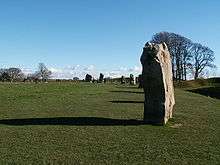Ritual landscape
Ritual landscapes are extensive archaeological tracts that were seemingly dedicated to ceremonial purposes in the Neolithic and early Bronze Ages (c. 3500-1800 BC). The term emerged in the early 1980s in British archaeology and was contrasted with more conventional studies of monument sites concerned with dating, classification, and political divisions.

Many ritual landscapes were gradually built around the two earliest classes of Neolithic communal monuments, known as long barrows and causewayed enclosures.[1] The evidence of contemporary settlement within these landscapes is often sparse or absent altogether; conversely, non-utilitarian structures and artifacts are typically abundant.[2]
Ritual landscapes went out of use relatively abruptly around 1500 BC and were replaced by smaller-scale shrines, which were often located near rivers, marshes, and springs. These smaller shrines usually feature offerings of food and metalwork, and continued to be created and used into Roman and even Saxon times. Today they are often described as Celtic.[1]
References
- 1 2 Pryor, Francis (1 December 2015). "Ritual Landscapes by Francis Pryor". The London Magazine. Retrieved 6 September 2017.
- ↑ Robba, John G. (24 Feb 2007), The ‘ritual landscape’ concept in archaeology: a heritage construction